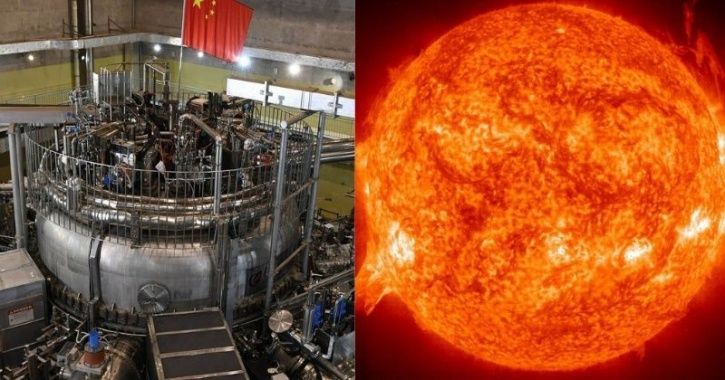China switches on its ‘Artificial Sun’ in its quest for nuclear fusion energy

When it comes to China, no feat is unachievable; it just turned on its artificial sun. China successfully powered its nuclear fusion reactor for the first time in history.
On Friday, the state media reported that the new generation nuclear fusion reactor research facility, through controlled nuclear fusion, had commissioned its new ‘artificial sun,’ which operates at a temperature that is ten times hotter than the sun.
China’s most advanced and the largest nuclear fusion experimental device – The HL-2M Tokamak reactor – is a device that the scientists hope will open the doors to powerful clean energy.
The HL-2M Tokamak apparatus, according to the China National Nuclear Corporation (CNNC), can operate at temperatures of 150 million degrees Celsius, which is almost three times hotter than its previous version, HL-2A.
The sun burns at a temperature of 15 million degrees Celsius, compare that to the ‘artificial sun’ of China, which reaches temperatures of 150 million degrees Celsius.
The ability of the HL-2M Tokamak reactor to generate such ultra-high temperatures is essential for the research of the fusion process and replicates how the sun produces energy using hydrogen and deuterium gasses as fuels.
Thus making HL-2M – china’s largest artificial sun with the best parameters, according to the institute’s director, Xu Min.
According to sources, this new facility also has three times the plasma volume and six times the plasma current intensity compared to the earlier HL-2A.
With HL – 2M uses a powerful magnetic field to fuse hot plasma; it is expected that it will substantially improve the research and development of fusion generator technology in China.
In addition, the HL-2M can achieve a magnetic plasma confinement time of up to 10 secs.
What is Fusion Technology?
It is a proposed form of power generation using the heat from nuclear fusion reactors, which is used to generate electricity.
This fusion process requires fuel and a confined environment with sufficient temperature, pressure, and a confined confinement time to create a plasma in which fusion can occur.
In its natural form in stars, the most common fuel is hydrogen, and gravity provides exceptionally long confinement times that reach the conditions needed for fusion energy production.
In fusion reactors, hydrogen isotopes such as deuterium and tritium are generally used.
Fusion Technology as a source of power
As a source of power, Fusion Technology is thought to have many advantages compared to fission. These include reduced radioactivity in operation and little high- level nuclear waste, ample fuel supplies, and increased safety.
However, the catch here is that the necessary combination required of temperatures, pressure, and duration is difficult to produce in a practical and economical manner.
China’s Aim
China intends to develop its fusion technology since it plans to build an experimental reactor early next year, build an industrial prototype by 2035 and go into large-scale commercial use by 2050.
Chinese scientists have been working since 2006 to develop smaller versions of the nuclear fusion reactor.
By developing nuclear fusion energy, China hopes to solve its strategic energy needs and its future sustainable development of China’s energy and national economy.
They are also looking to work with the scientists working on a similar project, which incidentally is also the largest nuclear fusion project based in France.
Other Countries looking at their own ‘Artificial Sun.’
France is also looking to take advantage of the technology, and the International Thermonuclear Experimental Reactor (ITER), which is under construction in the southern province of France, is also designed to operate at up to 150 million degrees Celsius.
Meanwhile, Korea too had announced earlier this week that the Korea Institute of Fusion Energy, its reactor had successfully succeeded in operating at 100 million degrees Celsius for at least 20 seconds.
In November this year, Beijing’s national technology development blueprint committing to achieve breakthroughs in key and core technologies, including artificial intelligence, aerospace science, and deep Earth and ocean exploration.
Fusion – the Holy Grail Of Energy, Safety, and Environment impact
Through Fusion Technology, The world can successfully solve its energy and power needs.
However, the necessary combination required – temperature, pressure, and duration – is challenging to produce that is both practical and economical.
Unlike nuclear fission, fusion requires an extremely precise and controlled environment – Temperature, pressure, and magnetic field parameters for net energy to be generated.
In case the reactor suffers any damage or incase it loses even a small semblance of required control, both fusion reactions and heat generation will quickly stop.
Also, the fusion reactors contain a minute amount of fuel, only sufficient to burn for a couple of minutes and in some cases seconds, and unless they are actively fueled, the reactions will cease; because of this, they are considered to be relatively safe and immune from a catastrophic meltdown.
In the plasma approach, plasma is burnt at ideal conditions, and any significant change in the same would quench the reactions. This entire process is so crucial and delicate that this level of safety is an inherent feature. The plasma density is low, and in most cases, only a minute of fuel is used; hence if the supply of the fuel is closed, the entire process stops within seconds.
The likelihood of small industrial accidents, including radioactivity and injury to people employed, is minor in nature compared with fission.
Fusion reactors are also considered to create much less radioactive material as compared to fission reactors. Also, the waste material it would produce is considered to be less damaging biologically.




